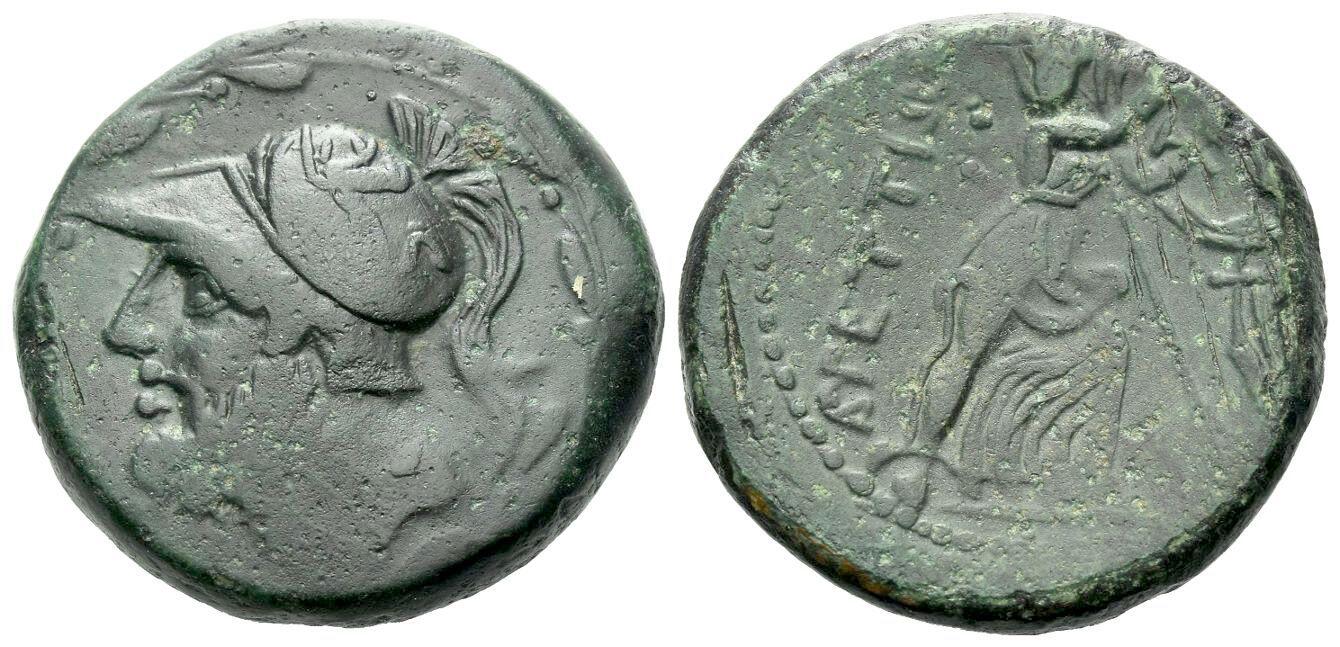Revision as of 12:22, 25 December 2023
214 BCE - 150 BCE | ΡΗΓΙΝΩΝ
Overstriking coin
SO 1417 - Rhegium (AE pentonkion) over uncertain type.jpg
[1]
|
|
Sale(s)Sale(s) ᵖ:
|
Classical Numismatic Group, MBS 67, 22 Sept. 2004, 199
|
|
|
|
Description
| ObverseInscription or printing placed on the obverse.:
|
Jugate draped bust of the Dioskouroi right, wearing pilei with stars. Border of dots.
|
ReverseInscription or printing placed on the reverse.:
|
ΡΗΓΙΝΩΝ (Greek) Hermes standing facing, head turned left, wearing petasos and drapery, holding caduceus and drapery. In left field, Π (value mark). Linear border.
|
Mint and issuing power
| MintIdentifies the place of manufacture or issue of a numismatic object.:
|
Rhegium
|
Ancient regionAncient region.
|
Bruttium
|
Modern countryModern country: Italy
|
AuthorityIdentifies the issuing power. The authority can be "pretended" when the name or the portrait of X is on the coin but he/she was not the issuing power. It can also be "uncertain" when there is no mention of X on the coin but he/she was the issuing power according to the historical sources:
|
|
Chronology
| FromIdentifies the initial date in a range assigned in a numismatic context. 214 BCE toIdentifies the final date in a range assigned in a numismatic context.. 150 BCE
|
Hellenistic 323-30 BC  periodTime period of the numismatic object. periodTime period of the numismatic object.
|
Physical description
MetalThe physical material (usually metal) from which an object is made.: Bronze 
|
WeightWeight of the numismatic object (in grams). in grams: 15.4615.46 g <br />15,460 mg <br />
|
DenominationTerm indicating the value of a numismatic object. Examples: tetradrachm, chalkous, denarius.: pentonkion
|
|
|
|
|
References
Description
| ObverseInscription or printing placed on the obverse.:
|
Head of Ares l., wearing crested Corinthian helmet, within wreath
|
ReverseInscription or printing placed on the reverse.:
|
BPETTIΩN in left field (Greek) Athena standing r., holding spear and shield, in r. field, lyre
|
Mint and issuing power
Chronology
| FromIdentifies the initial date in a range assigned in a numismatic context. 208 BCE toIdentifies the final date in a range assigned in a numismatic context.. 203 BCE
|
Hellenistic 323-30 BC  periodTime period of the numismatic object. periodTime period of the numismatic object.
|
Physical description
References
References
- ^ Troxell, Hyla A. (1975), Sylloge Nummorum Graecorum ANS 3. The Collection of the American Numismatic Society. Sicily 3 (Bruttium-Sicily I: Abacaenum-Eryx), New-York, pl. 38.
- ^ Rutter N. Keith et alii (eds.) (2001), Historia Numorum Italy, London, xvi, 223 p., 43 pl.
- a b Hoover, Oliver D. (2018), The Handbook of Greek Coinage Series, Volume 1. Handbook of Coins of Italy and Magna Graecia, Sixth to First Centuries BC., Lancaster-London, 2018, lxi, 527 pages, 23 cm
- ^ HN Italy 1987

